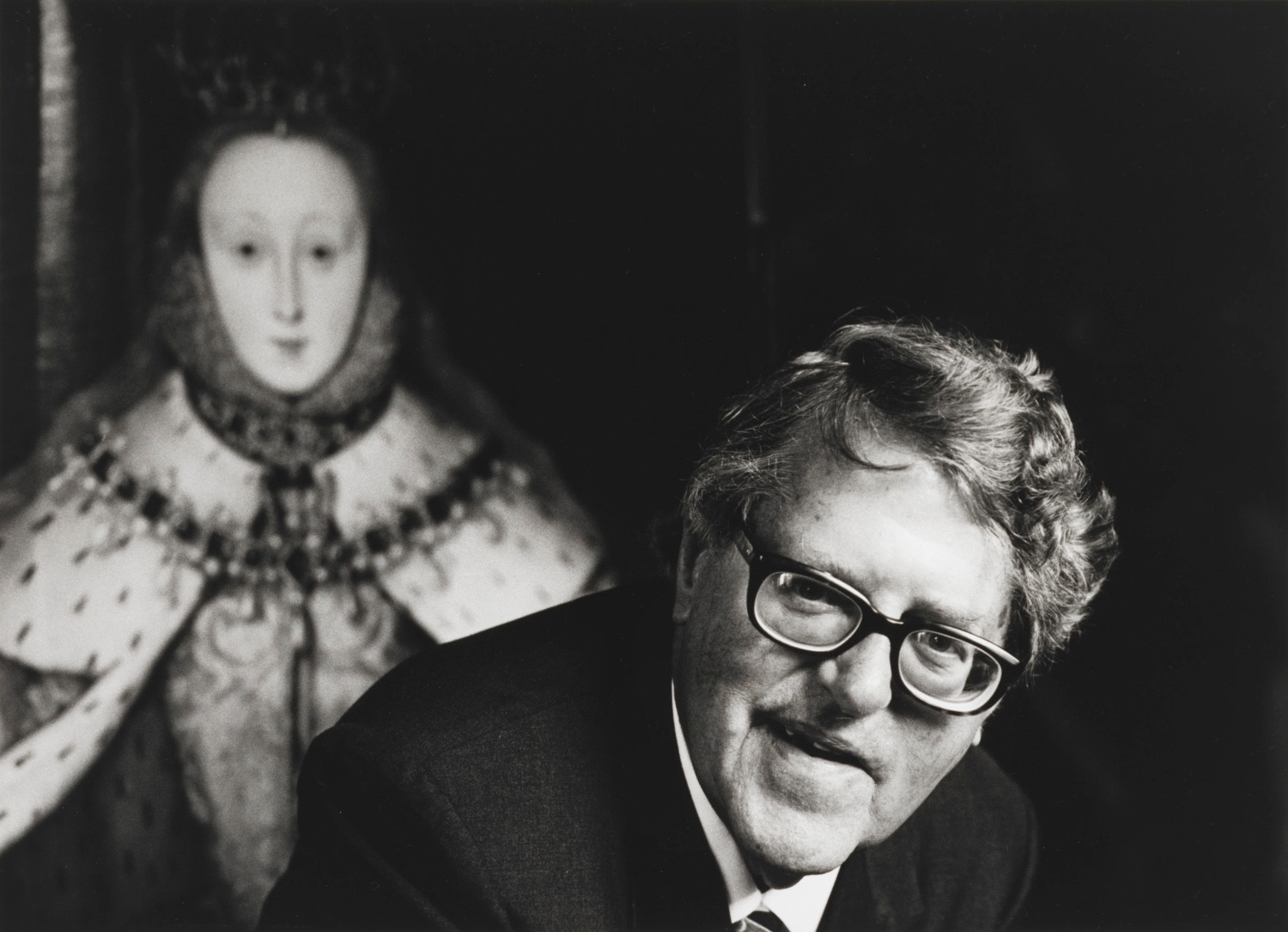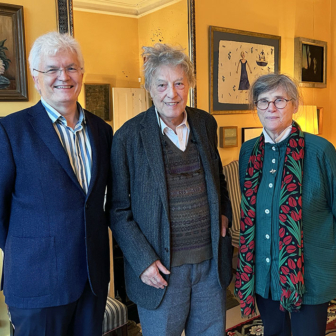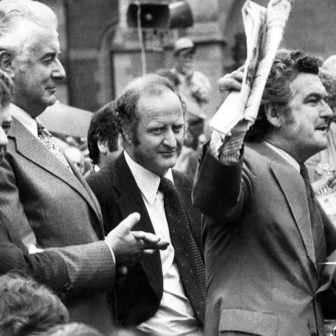The novelist Ian McEwan once remarked that the sum of a writer’s career might only be the one or two feet of space their books occupy on a shelf. For anyone reckoning with the career of the historian Asa Briggs (1921–2016), who wrote fifty-plus books, that shelf space would only tell half the story.
Briggs crammed careers into his life like so many cats in a sack. He was a brilliant student who simultaneously studied for degrees in history and economics at Cambridge and the University of London. He worked at Bletchley Park as part of the Intelligence Corps during the second world war and was the youngest warrant officer in the British army. He proofread and advised on Churchill’s A History of the English-Speaking Peoples (1956–58). He was a precociously young fellow at Worcester College, Oxford, an energetic history professor at Leeds and Sussex Universities, a pioneering university administrator (including stints as provost of Worcester College, vice-chancellor of Sussex University and chancellor of the Open University), a British peer, and a tireless advocate for education.
His books, meanwhile — particularly Victorian People (1954), The Age of Improvement (1959) and Victorian Cities (1963) — enjoyed credibility in the academy and popularity with the public. He produced a wide range of commissioned histories, most notably a five-volume history of broadcasting in Britain (1961–95), and he was a mover and shaker in all manner of British cultural institutions and societies throughout the latter half of the twentieth century.
For a biographer, cramming such a life into a book of manageable length is a challenge; recovering its details, too, requires vast reservoirs of energy. It is for this reason that the appellation biographer Adam Sisman gives to Briggs — “indefatigable” — must surely also apply to Sisman himself. He has traversed Briggs’s corpus, trawled the three voluminous collections of Briggs’s papers, and quarried from a range of other sources — books, periodicals, interviews — the materials needed to recount this man’s ceaseless, bustling life in his relatively succinct new book, The Indefatigable Asa Briggs.
Born in Keighley, Yorkshire, to a lower-middle-class family, Briggs showed himself early to be a voracious reader with a seemingly bottomless appetite for learning. Scholarships and prizes piled up quickly, as did signs of his brilliance. At fourteen he was sitting the exams his peers took when they were sixteen and writing essays on topics that would flummox an undergraduate: “Analysing Chaucer’s prose style, for example,” Sisman writes, “or examining the evidence that Francis Bacon wrote Shakespeare’s plays.”
Sisman gives close attention to the Yorkshire milieu that shaped Briggs, especially its history since the Industrial Revolution, and to his family. In the first, he detects the origins of Briggs’s famous interest in the Victorian age; in the latter, he identifies how personality and class intersected with the imperatives of business throughout his life.
His father was a former fitter whose family thought themselves “superior” people and retail trading “absurd.” Willie Briggs had become a grocer with considerable reluctance, was uninterested in the business, and when the store failed through his inattentiveness he turned to the bottle. The family thus moved from their hitherto relatively secure existence, on the edge of the slums in Keighley, to far more precarious and straitened circumstances, with young Asa having to sleep in the attic and the family reliant on a loan from an in-law.
Against this background, it was by no means certain that Briggs would head off to university. His father was certainly unconvinced — no one else in the family had gone, after all — and a local schoolmaster thought the youngster should go into catering. Thankfully, a more perceptive and accomplished colleague convinced Briggs’s father otherwise, and in 1937 he sat for a scholarship examination for Cambridge. Though he was just sixteen, he was urged to be speedy by the history fellow who interviewed him: “Briggs, you are only a baby, but there is going to be a war and I would like you to take your degree before you go into uniform.”
That sense of urgency appears never to have left Briggs. Thus the two simultaneous degrees; thus the book he co-authored on the postwar peace after-hours at Bletchley. Once the war ended, Oxford and Cambridge began fighting for his talents and a great stream of work began to flow. By then a tubby and genial young man with pebble-thick glasses, he was on the up. He swiftly built a reputation, writing the second volume of a two-volume history of Birmingham, doing regular broadcasts on the BBC, reviewing books for newspapers.
He began rubbing shoulders with the eminent, the established and the emerging. He was “moral tutor” to a young Rupert Murdoch (!) at Oxford and a lodestar to a swooning Iris Murdoch. A pensive J. Robert Oppenheimer asked him what to do about students protesting against nuclear weapons; Albert Einstein took a taxi with him; Clement Atlee told him that Churchill was right about Gallipoli.
Briggs’s greatest period was at Sussex. Established in 1961 as part of the British government’s efforts to expand higher education, it was one of the first “plate-glass” universities. As an early recruit and inaugural pro vice-chancellor, Briggs was instrumental in its adoption of multidisciplinary teaching. Having chafed at more conservative course structures at Oxford and Leeds, he wanted students to have a balance between a general education and a specialised one, enabling them to understand the connections and benefits of bridging the humanities and sciences. In its early years, as the campus was being built, the small student body and the frisson of creating a new institution was infectious. “Life is hectic here,” Briggs wrote to a friend, “but exciting.”
As vice-chancellor from 1967–76, Briggs had more to contend with than campus works. Student protests and faculty politics — particularly turf wars — would sour some of Sussex’s early promise. But for him this was still a high point. He was writing, publishing, hobnobbing. He was greeting royalty as easily as student protestors. When the Queen came to open the library, she stayed in a house nearby and “recruited Asa in rearranging the chairs in the sitting room after dinner,” writes Sisman. “Asa seemed completely at ease when talking to her. He had come a long way.”
With biographies of A.J.P. Taylor and Hugh Trevor-Roper, most pertinently, to his name, Sisman is practised at writing about historians and tracing the heady currents of experience and scholarship that surround them. He moves lightly through terrain that might otherwise have bogged him down and maintains a focus on why Briggs’s life and work may be worth reading about.
As he points out, the work of most historians is, ultimately, of passing significance. It is built on, at best; demolished, at worst; and often simply built over. Subsequent generations find new evidence, ask divergent questions, take up different perspectives. Works lauded and applauded in one decade may become outdated and unread in the next.
Briggs never liked that idea. “I believe that my books will be thought of as definitive in years to come, and not simply as interpretative,” he wrote. Sisman is not altogether convinced, but he is clear about why Briggs and his work are important. “He was a pioneer, who ventured into previously unexplored areas of study…,” he writes. “When others followed him into such new territories, he would move on, rather than claiming them for his own and colonising them, as others did… The terra incognita he had first explored would subsequently be developed in greater detail by others.”
For Australian readers, this point is evident in Briggs’s influence on Australian historiography and historians, which originated in the six months he spent as a visiting fellow at the ANU in the latter half of 1960, right before he joined Sussex University.
As part of his duties, Briggs went round Australia, lecturing, researching and engaging with scholars: responding to their concerns, paying attention to their ideas, taking part in their debates. The results were diffuse and catalysing. He was influential in the formation of the Australian Society for the Study of Labour History; he encouraged emerging work in urban studies, foreshadowing the creation of the Urban Research Unit at the ANU in 1965.
Beyond this visit, moreover, Briggs’s own books were talismanic examples to emulate and build on. His former student Ken Inglis’s This is the ABC (1983) and Whose ABC? (2006) are indebted to Briggs’s history of British broadcasting; Graeme Davison’s Rise and Fall of Marvellous Melbourne (1978) seems to answer the ideas and suggestions Briggs made in Victorian Cities.
As Frank Bongiorno has argued, Briggs’s work was a “catalyst, a provocation, and a reassurance.”
For the first half of The Indefatigable Asa Briggs, the tone is one of optimism. When he took up the post at Sussex, Briggs’s life seemed to be one of constant ascension. He was always writing (1500 words a day), publishing new books, taking up lofty appointments, going on tours, being solicited for profiles and attention. Everything was coming his way. Nothing could go wrong. The mood is of energy, happiness, confidence and buoyancy.
But the more sombre notes Sisman strikes, with increasing frequency, begin to unsettle that impression. The pace never slows. New achievements and high appointments become so frequent as to seem insignificant. Books, children, new homes, new friends, new opportunities, pile up. The result is a flattening — as though Briggs has become mired.
In a sense, he had. Instead of casting off the demands of old roles as he moved into new ones, he seemed determined to maintain all. The result was endless delays in his delivery of manuscripts and a decline in the quality of that (still often very good) work. Commissions for which Briggs had accepted money, book proposals for which he had signed contracts, promises he had made: everything was made to revolve around him and his needs. Students needing to speak with Briggs would accompany him on the train to Gatwick to hear him say, “Yes, yes, yes,” as they told him what they had done. Publishers drumming their fingers for a long-overdue manuscript would write admonishing letters and then revise their catalogues. Even books that were finished could be haphazardly done: “Just put page 50,” he told his assistant when she queried incomplete footnotes.
The results were books that were insubstantial, marred by errors, outdated, lumbering and even stillborn. He delivered his history of Longmans three decades after the original seven-year commission; his history of British broadcasting, originally two volumes taking seven years, took five volumes and thirty-seven years.
Briggs’s heyday ended well before his life. Margaret Thatcher might have seemed to pay him a compliment when she suggested her government was reclaiming Victorian values, but the Gradgrind-turn of British politics that followed in the 1980s suggests otherwise. Causes that Briggs had espoused and championed — particularly in education — were out of favour. Publication of a festschrift titled Age of Asa, in 2014, implicitly acknowledged that the titular age had passed.
Sisman is judicious in explaining all this. He ventures, convincingly, that Briggs’s determination to succeed, and his willingness to take on paid commissions even when he could not meet them, was a response to the indignities he witnessed in boyhood when his father’s shop failed. He acknowledges too that class may have been an influence, pointing out that colleagues who called Briggs “greedy” may not have ever worried, as Briggs had, about money and security. “The childhood scars remained,” Sisman writes.
But there is also a mounting sense that Briggs’s relentlessness, his constant activity, was also a diversion from something deeper and more elusive. Briggs once wrote in a journal of a desire “not to reveal too much about myself,” and in lieu of doing so he seems to have loaded himself up with tasks. “My labours are far from finished,” he wrote when he was in his eighties, at a point when most people are putting their feet up. It is a declaration that pushes Sisman to conclude that Briggs’s habit of constant activity “had become a compulsion, perhaps even a raison d’être.”
For Briggs, there was always something to do. Ian McEwan had seen this, in 1970, during his final year at Sussex. Briggs was giving a lecture to commemorate the centenary of the first national Education Act. Student protestors arrived to disrupt the event, but Briggs told them if they waited until the lecture was over he would talk to them, properly. They waited. And so, at the end, as the audience began to disperse, Briggs took off his jacket to address the next item on the list. He announced: “And now, down to business.” •
The Indefatigable Asa Briggs
Adam Sisman | William Collins | $59.99 | 480 pages




